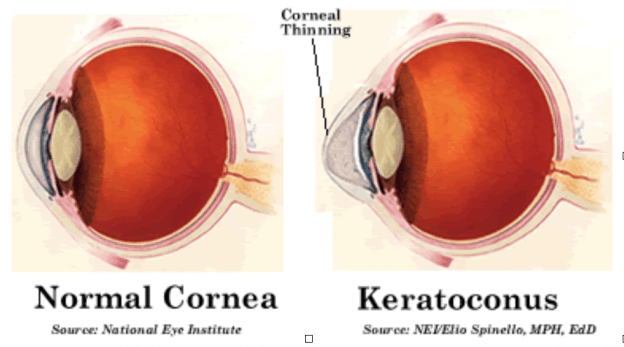Keratoconus
Keratoconus is a condition in which the cornea is shaped abnormally; instead of having the regular dome shape, the dome has sagged, sometimes even turning conical (see illustration: left normal, right keratoconus). This is caused by a deviating structure of the corneal tissue, as a result of which it loses its strength and thickness. Usually this condition is double-sided, but the severity of the condition can vary from left to right.
What is the cause of keratoconus?
Keratoconus usually develops after puberty and may gradually grow worse up to the age of 40. In approximately 10% of the keratoconus patients the abnormality is hereditary. People with a keratoconus often have an allergic predisposition or eczema, experience their eyes as sensitive and often have an itching sensation in their eyes.
Because the cornea is the most important refractive medium of the eye, the abnormality in shape has major visual consequences. The strength of the eye changes and there will be an increase in astigmatism. Scars may occur in the cornea, reducing vision even further.

What can be done about keratoconus?
A spectacle correction is usually insufficient to correct this deviation. Rigid, oxygen-permeable contact lenses are then first choice for the correction of refractive errors in keratoconus. They form a new surface. There are various specialized keratoconus-lenses. When an eye reacts overly sensitive to a rigid oxygen-permeable lens, a piggy back system can be used; placing a rigid lens on top of a soft one. In addition, a large lens (sclera lens) may sometimes be required, laying on the white part (the sclera) of the eye.
If lenses are no longer tolerated, intracorneal rings can be considered. Contact lens-tolerance can be improved with these intracorneal rings. The next step is a partial or entire corneal transplantation. After a corneal transplant glasses can be prescribed, but it may also be necessary to use contact lenses again, always in the form of rigid oxygen-permeable lenses. Incidentally, keratoconus treatment with the excimer laser is not possible. There are no eye drops to take away the cause, either.
A newer technique is collagen cross-linking. Cross linking is not meant to be an alternative to the abovementioned agents (eg contact lenses) to improve vision, but it is intended as a separate treatment to prevent further corneal distortion. This method is meant to strengthen the collagen tissue of the stroma – the middle part of the cornea – through a vitamin B-preparation and ultraviolet light, in order to slow down or halt any further bulging of the cone. This method is only used when there is a significant increase in the curvature deviations of the cornea.
Not all information on this page is necessarily applicable to you. If you still have questions after reading this information, please contact OMC Amstelland.
Source: NOG patient information – www.oogheelkunde.org
